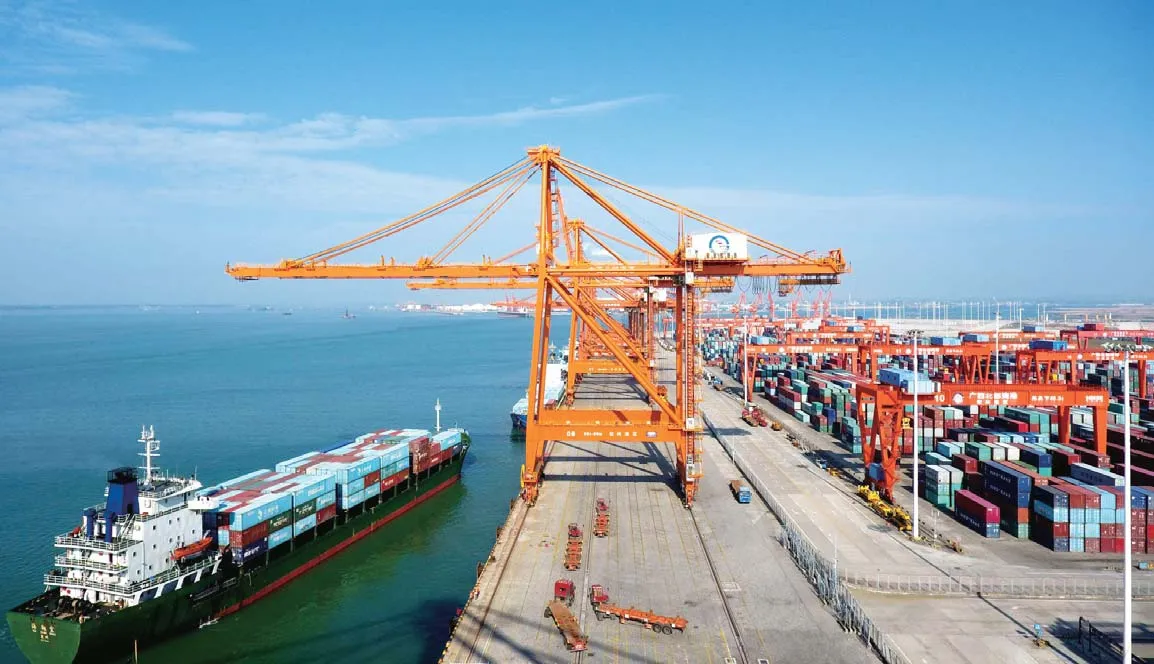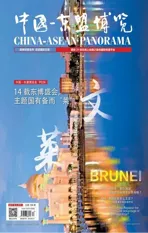Chongqing-Guangxi-Singapore Southward Passageway to Provide Logistics Services for Trade Contacts Along the Route
2017-09-20WrittenbyLyuJunfenTranslatedbyXuZhiliang
Written by Lyu Junfen / Translated by Xu Zhiliang
Chongqing-Guangxi-Singapore Southward Passageway to Provide Logistics Services for Trade Contacts Along the Route
Written by Lyu Junfen / Translated by Xu Zhiliang

Guangxi Beibu Gulf energetically pushing ahead with the construction of Chongqing-Guangxi-Singapore Southward Passageway
After launching Chongqing-Guangxi-Singapore Southward Passageway (CGSSP), a transportation infrastructure project under China-Singapore(Chongqing) Demonstration Initiative on Strategic Connectivity, Chinese consumers now can get their parcels containing external commodities, such as Singapore’s watches and Thailand’s durian, within less than half a month, signaling that China has been closely associated with countries along the Belt and Road routes.
CGSSP is jointly planned by both Chinese and Singaporean enterprises, with the focus on developing a multimodal transport network dominated by railways and sea routes.
At present, Guangxi is dedicated to building the part of CGSSP located in Guangxi’s area of jurisdiction, aiming to organically link the Silk Road Economic Belt with the 21stCentury Maritime Silk Road. As the construction of CGSSP continues,not only will the time and cost of delivery be dramatically reduced, but also logistics enterprises along the route will embrace tremendous business opportunities.
An extraordinary time- and cost-effective intermodal transport
CGSSP — the fi rst international logistics passageway featuring domestic and foreign trade in China’s western region — is connected northwards to Sichuan province and Chongqing city, as well as to areas along the Chongqing-Xinjiang-Europe Passageway, and is linked southwards with nine ASEANcountries by sea and with seven countries on the Indo-China Peninsula by land. Now, for ASEAN and China’s inland areas,there is a tremendous demand for both trade and logistics services. As indicated by the statistics, the annual value of import and export between ASEAN countries and Chongqing city or its surrounding areas approximately amounts to US$ 30 billion, with an annual growth rate of over 10%. In addition,CGSSP focuses on making a highly-stable intermodal transport network combining railways and sea routes available to areas along the passageway, markedly reducing not only transport time but also logistics cost.
The transport time has decreased by over 12 days by trains running on the route of CGSSP compared with the previous transport route, Mr. Zhou Xiaoxi, president of Guangxi Beibu Gulf Port Group, said when attending China (Guangxi)-Singapore Economic and Trade Cooperation Conference held a few days ago.
Over a long period of time, more than 90% of Chongqing’s exports have always been first transported to Shanghai Port through the Yangtze River waterway and then to the outside world by sea. The transport efficiency, however, remains relatively low owing to two main factors: One is the regular examination and repair of the Three Gorges Ship Lock, and the other the dry season of channel. In comparison, CGSSP has significant advantages in this respect. For instance, the transport distance between Chongqing and Singapore has been reduced by more than 2,100 kilometers.
In the meantime, work has been done to foster an international container intermodal transport market along CGSSP: Since July 1, 2017, the freight charges of over 90% of export goods have decreased in varying degrees. In terms of containerized goods, average freight rates have dropped by 20%, which is undoubtedly a good start for the market.
A golden passageway for logistics
As the construction of CGSSP advances, international logistics is facing a promising future. Building CGSSP has opened a commerce and trade passageway to link Europe, Central Asia, Southeast Asia, Australia, New Zealand, South Asia, the Middle East and Africa, vastly lowering the inland logistics cost and boosting the logistics efficiency. In the future,Europe- and Central Asia-made products will be directly imported to Chongqing through the Chongqing-Xinjiang-Europe Passageway, sold to other areas of the Chinese market,and re-exported to Southeast Asian countries via CGSSP within less than 23 days, according to Mr. Li Feng, president of Jincheng International Logistics Group.
Guangxi Beibu Gulf Economic Zone (GBGEZ) is blessed with exceptional regional advantages in developing logistics, as it is not only a critical junction of CGSSP but also an area close to the border and sea. Now, Guangxi Shunfeng Express Liujing Distribution Center has entered Liujing Industrial Park,becoming one of three major locally-based transfer stations;Qinzhou Free Trade Port Area has set up many cold-chain storage projects such as Yilong, Chuangda and Yuhua and invested RMB 268 million yuan into the building of Thailand-China Cold-chain Logistics Base; Nanning Economic &Technological Development Area, relying on Nanning Wuxu International Airport and its surrounding transport network,is striving for an airport logistics circle featuring logistics,storage, bonded service, packaging and processing, as well as international trade, to name a few.
Furthermore, after launching CGSSP, a number of transnational logistics enterprises specializing in commerce and trade have been engaged in logistics services in GBGEZ and its surrounding areas.
On May 9, 2017, PIL-Pacific International Lines, Nanning Municipal Government and Guangxi’s Department of Commerce jointly signed a cooperation framework agreement on establishing Singapore-Guangxi Integrated Logistics Park(SGILP), in an effort to make Guangxi a crucial logistics distribution center along the transport route towards Southeast Asia; on May 17, 2017, Guangxi Pingxiang Integrated Free Trade Zone (GPIFTZ) and Chongqing Highway Transportation (Group) Limited inked a strategic cooperation framework agreement, under which the two parties shall make joint efforts to build Chongqing-Pingxiang-ASEAN Passageway, a section of CGSSP, and set up a platform for logistics cooperation.
“GPIFTZ will make remarkable achievements in developing bonded logistics when pursuing CGSSP. In particular,Pingxiang government and GPIFTZ have issued respective policies to promote the development of local bonded logistics industry in terms of rents, facilities, revenues and special funds,” said Mr. Qiu Minghong, executive deputy director of GPIFTZ and secretary of the Party Committee of Pingxiang.
With respect to CGSSP’s development priorities, Mr. Zhang Xiaoqin, Vice Governor of Guangxi Zhuang Autonomous Region, pointed out that efforts will be made to accomplish the following goals: launching the container railway line linking Lanzhou, Chongqing and Guangxi to enhance the international intermodal transport of railways and sea routes; opening the Vietnam-China container railway line and extending the Vietnam-China freight-transport highway line to improve the international intermodal transport of highways and railways;and building logistics park and intelligent logistics system based on railways, sea ports, road stations and airports.
